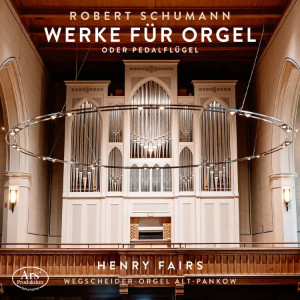
Robert Schumann (1810-1856)
Studies for pedal piano, Op 56 (1845)
Sketches for pedal piano, Op 58 (1845)
Six fugues on the name B-A-C-H, Op 60 (1845)
Album Leaf, Op 124 No 20 (1845)
Henry Fairs (organ)
rec. 2024, Church of the Four Evangelists, Pankow, Berlin
ARS Produktion ARS 38 376 SACD [67]
The front of the box says Werke für Orgel [works for organ] and, in much smaller letters, Oder Pedalflügel [or pedal piano]. The pedal piano, as Robert and Clara Schumann experienced it, was a set of pedals attached to a piano. That enabled the playing of low bass notes with the feet, like a pipe organ. The Schumanns had obtained the pedal set to study counterpoint and organ playing, but the possibilities of the pedal piano as an actual instrument were readily apparent. Robert began composing for it, but these works are now usually played on the organ (review ~ review).
Schumann’s first works for the pedal piano were the Six Studies in Canonic Form. They blend his recent interest in counterpoint with the style of his small piano pieces. The first and last depend the most on Baroque practices; the middle four are more lyrical and romantic. The appealing With fervent expression and the delightful Andantino could fit right into one of the composer’s piano cycles. The last study is more contrapuntal, but Schumann still manages to make it emotionally expressive.
Schumann returned to form with the Four Sketches for Pedal Piano. They show little Baroque influence. The focus is much more on the instrument to express the lyrical side of his nature. The first two have the same tempo indication, Not slow and very marked, but they are quite different. The first sounds a little like Schumann’s friend Mendelssohn’s music, and the second is in Schumann’s best energetic manner. The Lively sketch is stormy, almost orchestral. The Allegretto reminded me of some of the composer’s later choral Romanzen.
The Six Fugues on the Name B-A-C-H were written with the organ in mind as much as the pedal piano. They show that Schumann had profited from his contrapuntal studies. As an example, we have his clever manipulation of the B-A-C-H motif in No 2 and No 5; the other fugues are more typically Romantic. Mention must also be made of No 4 and No 6. The first starts gently but progresses to a monumental close. The second, perhaps the best known piece of all those on this disc, uses fugal form to produce an almost symphonic movement to close the cycle. As a pendant, we have a canon originally meant for Op 56, but only later included in the composer’s Album Leaves Op 124 for piano.
The organ at the Church of the Four Evangelists was built as a 20th-century version of an instrument of the kind that the great Berlin organ builder C A Buchholz might have created in Schumann’s time. Henry Fairs takes full advantage of the lightness of touch in such an instrument. I especially admired his pacing and the originality of his registrations. As far as we can tell today, this is what Schumann might have heard in a performance of the organ versions of these works. Fairs, formerly at the Royal Birmingham Conservatoire, and now Professor of Organ at the Berlin University of the Arts, is an excellent advocate for this less well-known part of Schumann’s output.
William Kreindler
Buying this recording via a link below generates revenue for MWI, which helps the site remain free


















